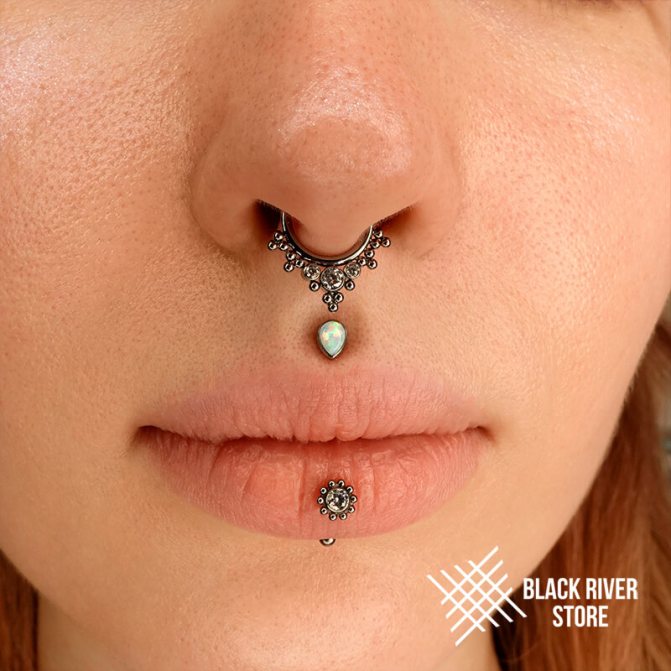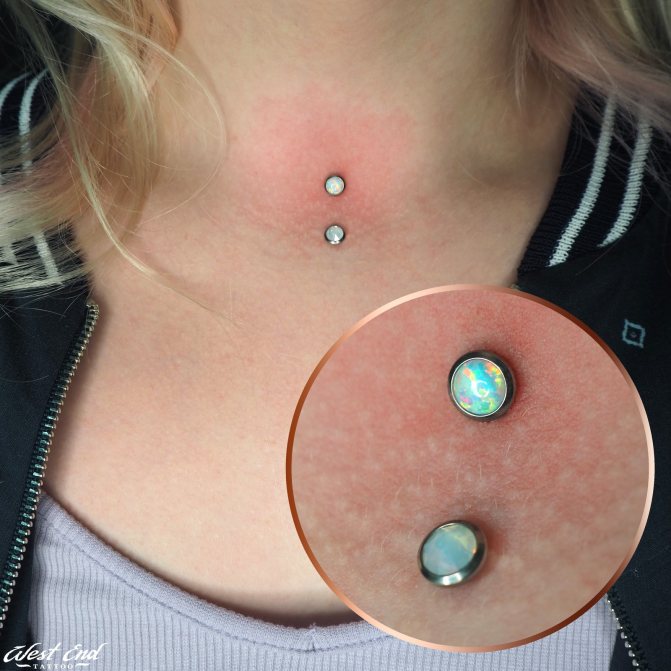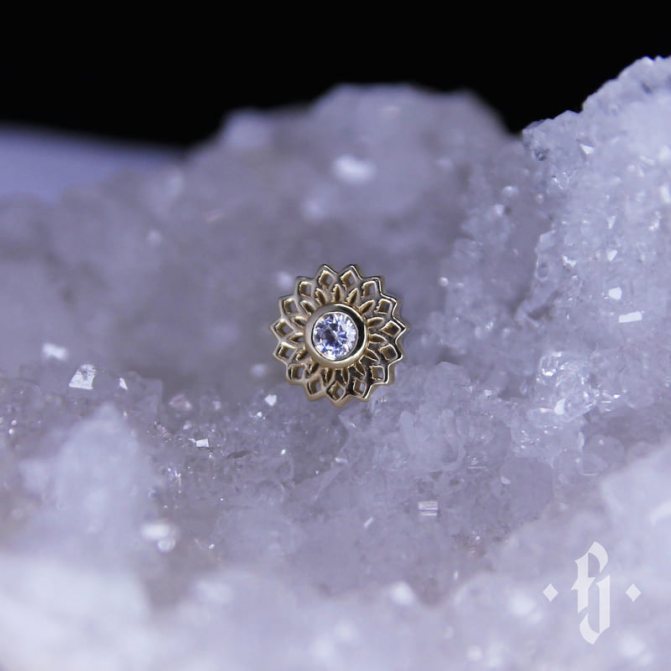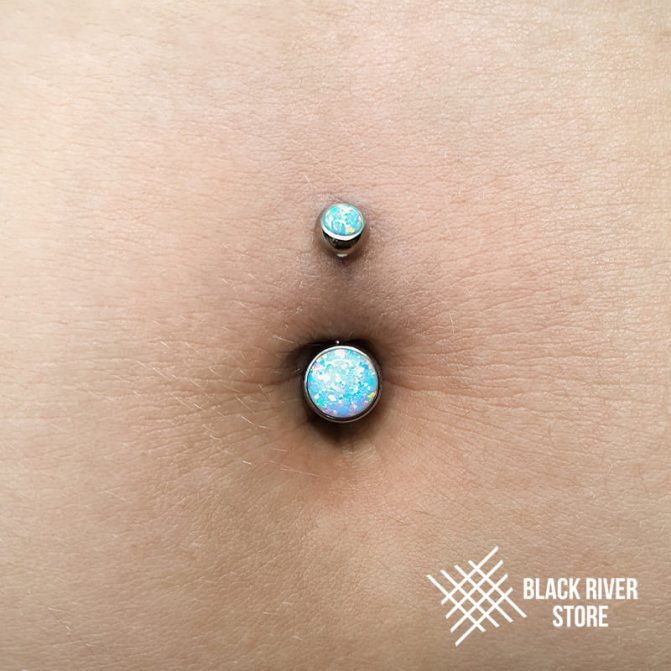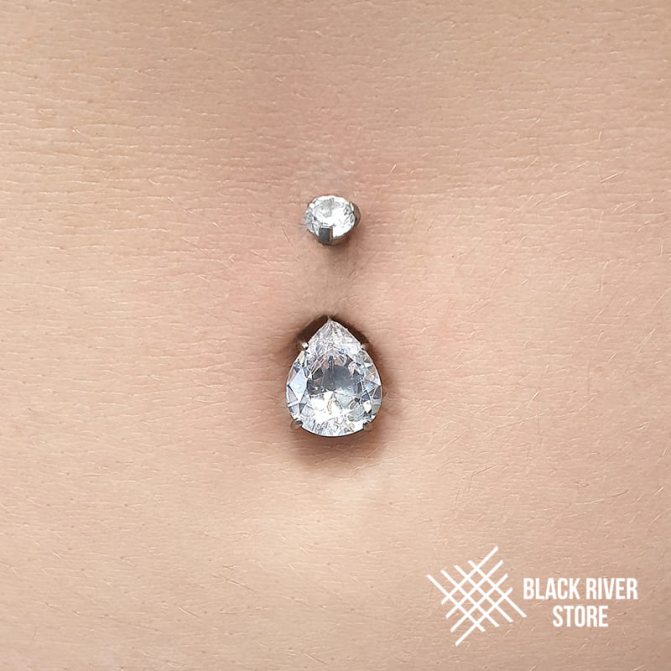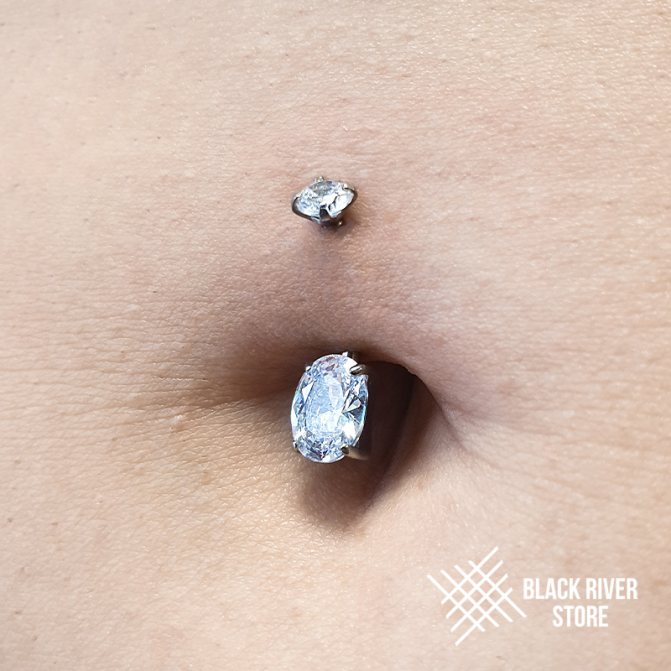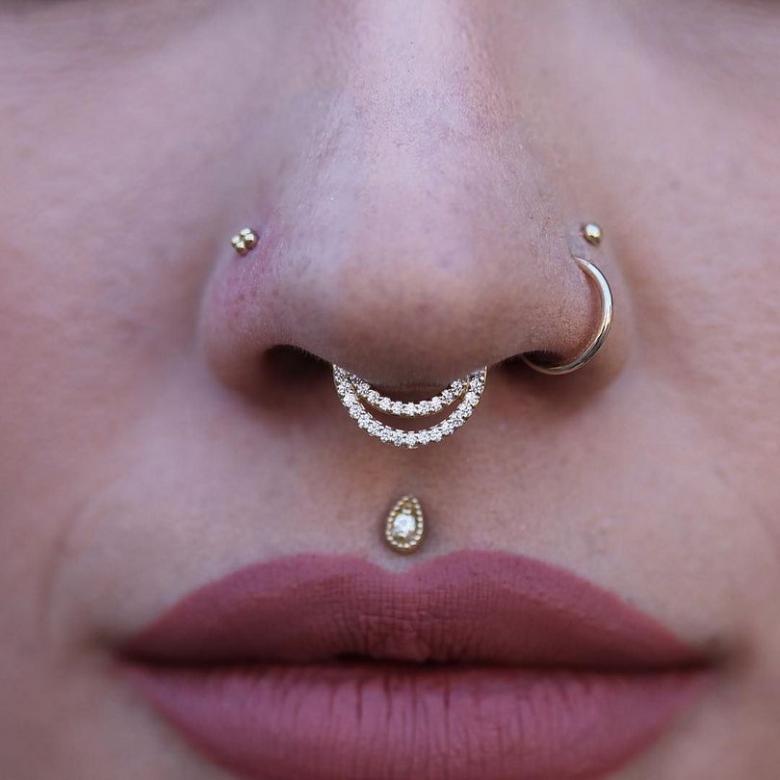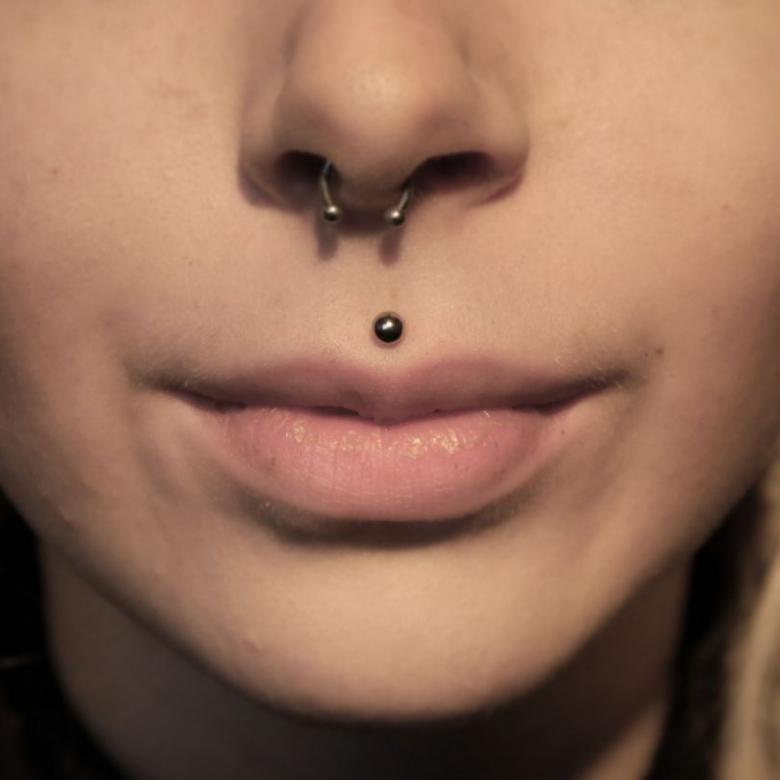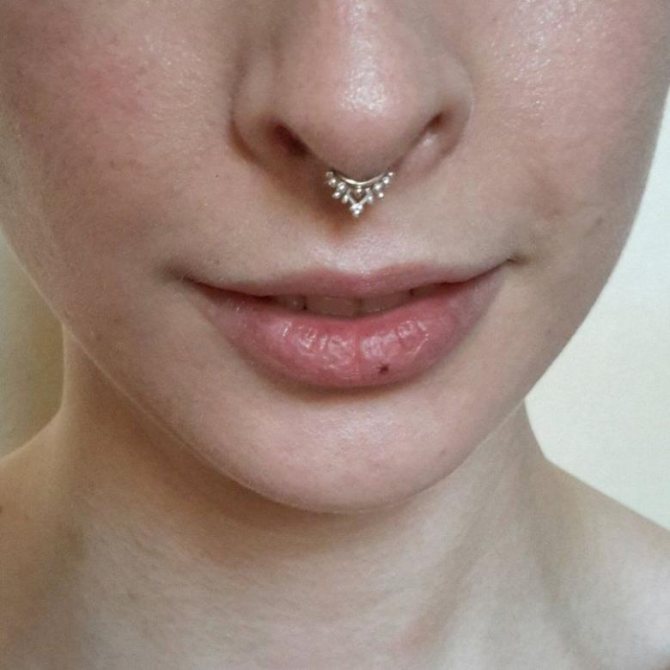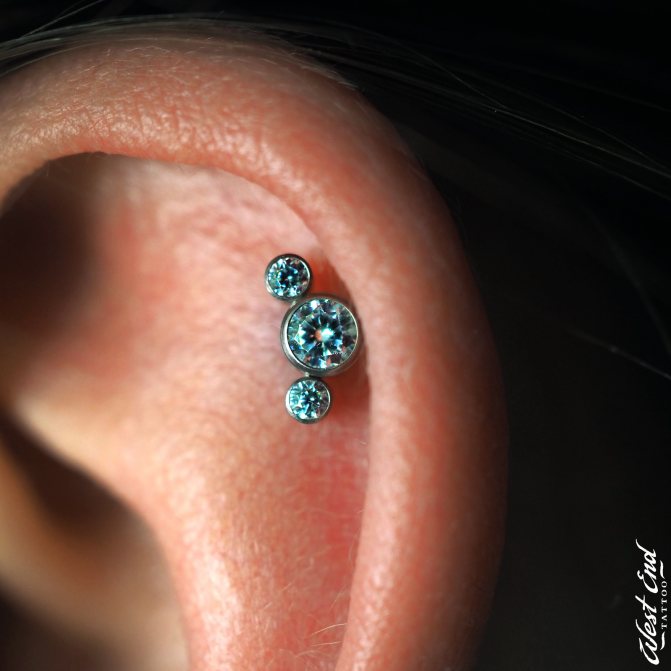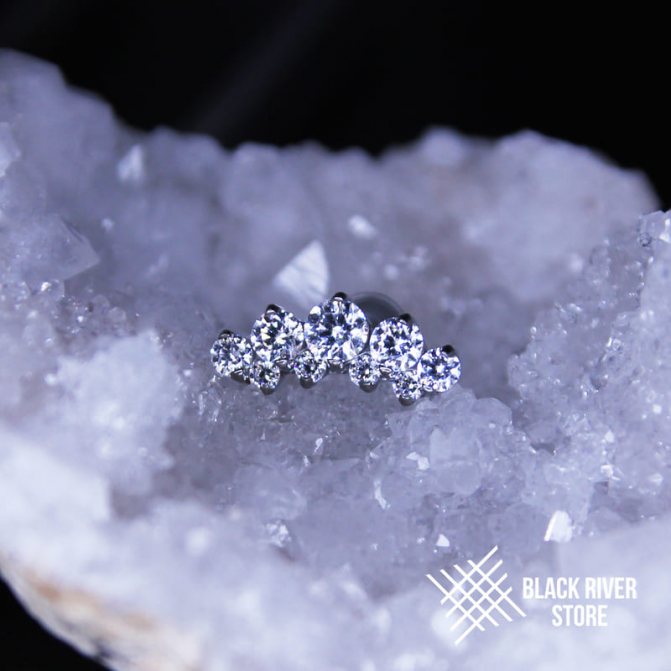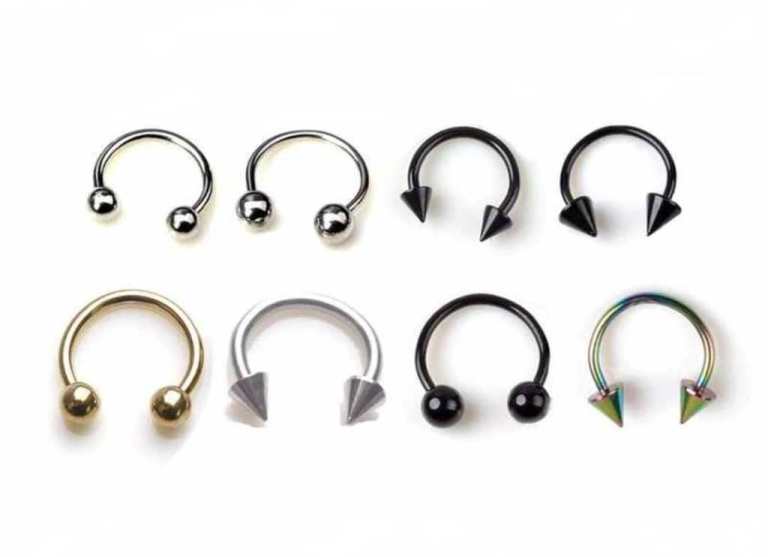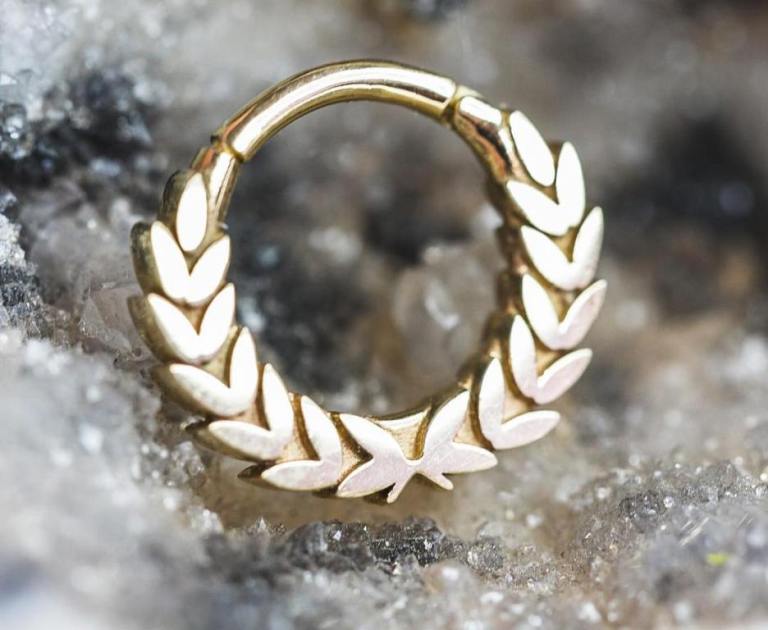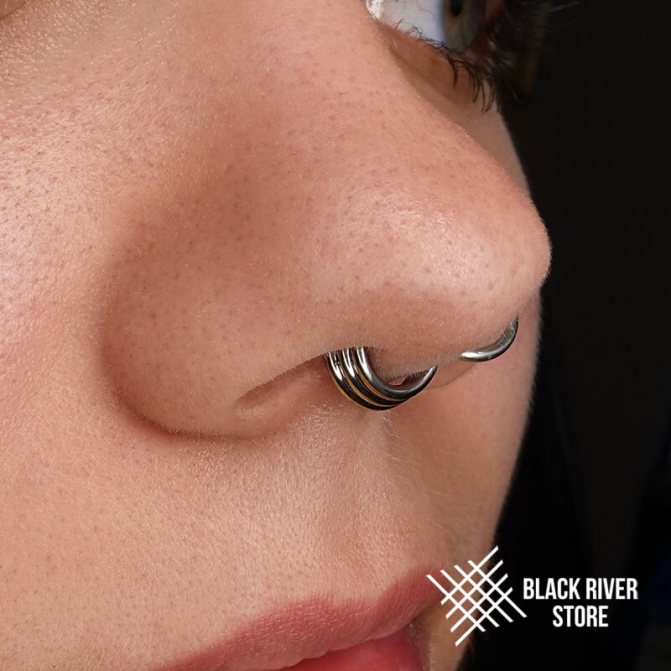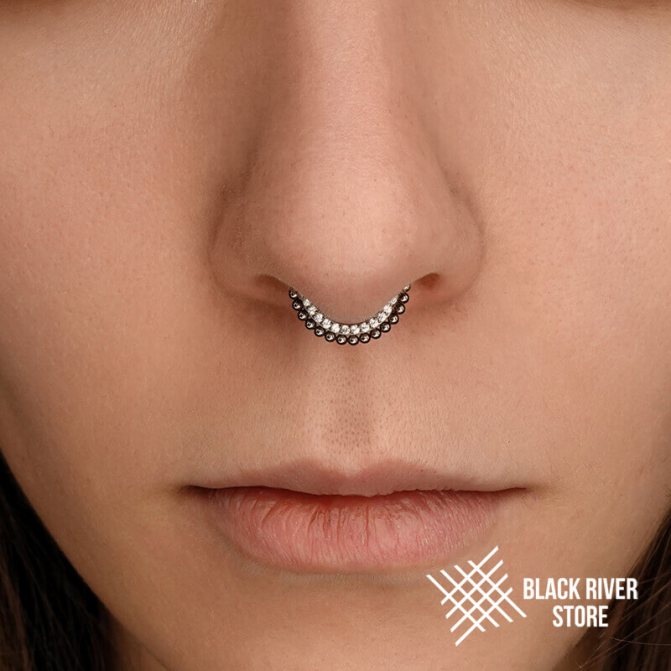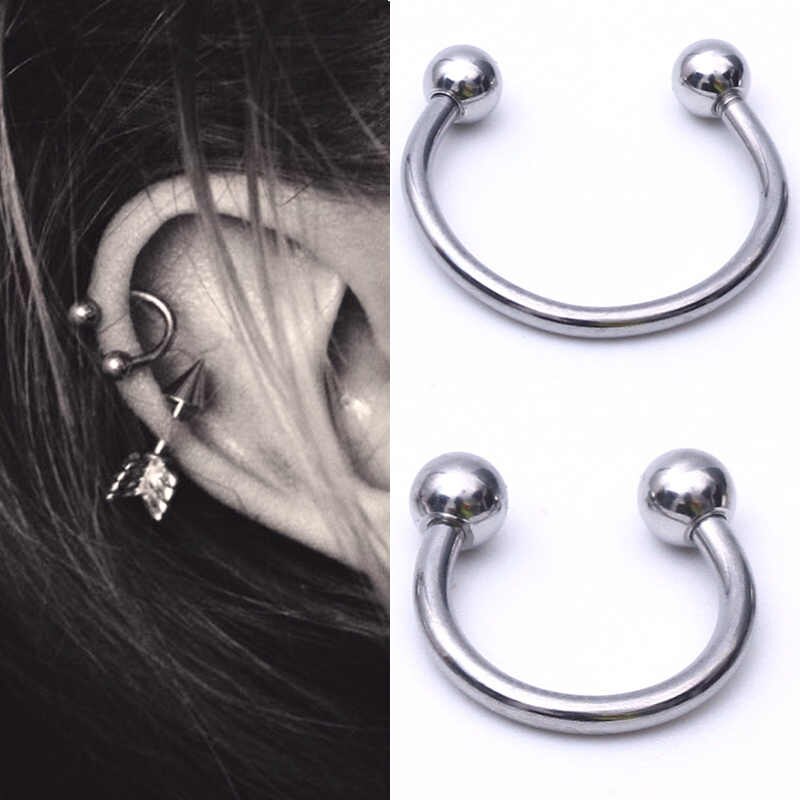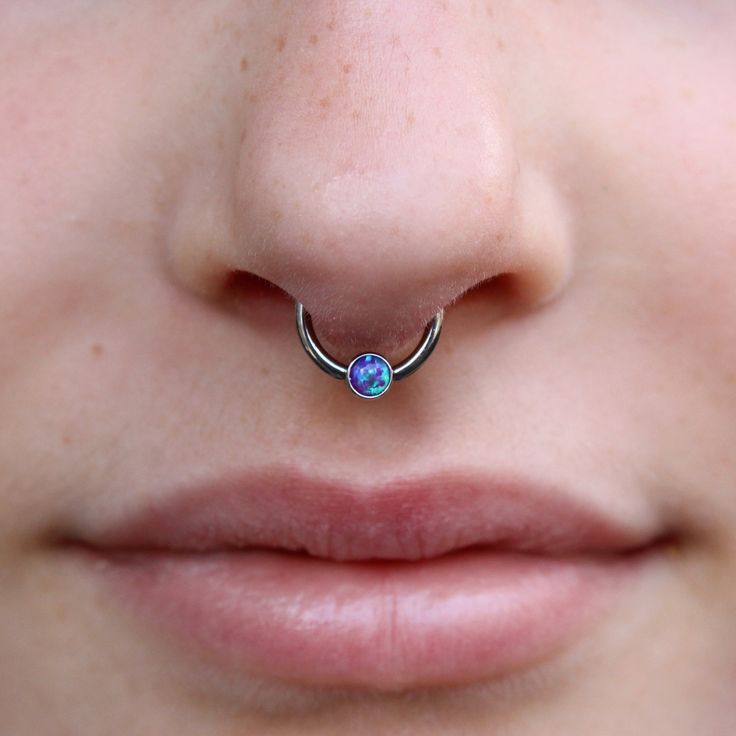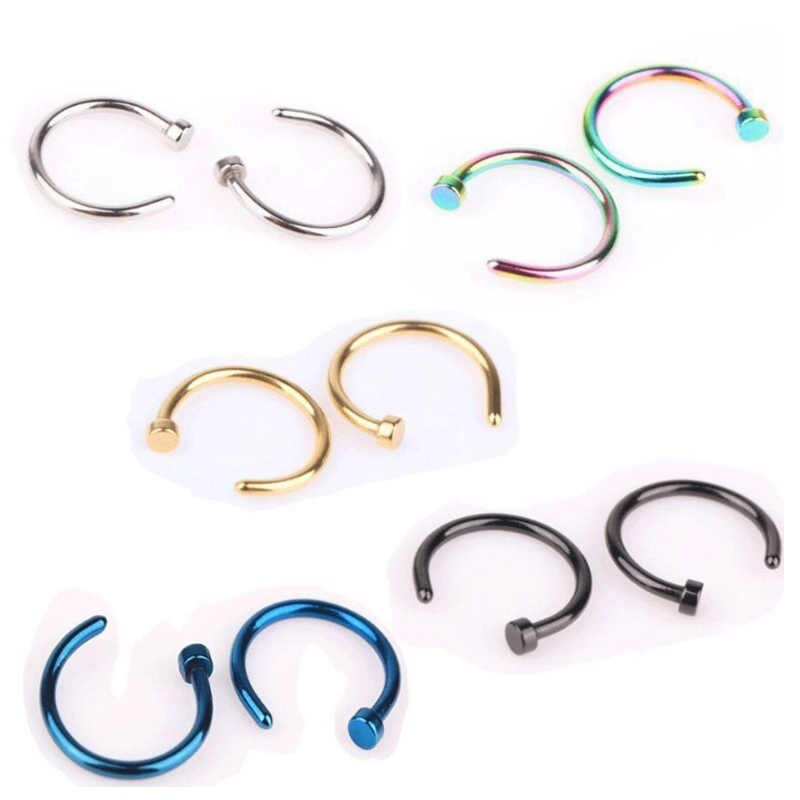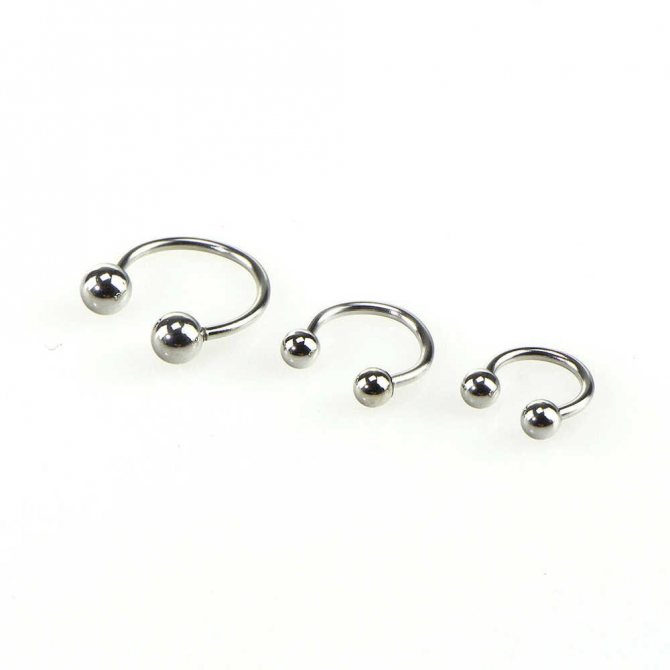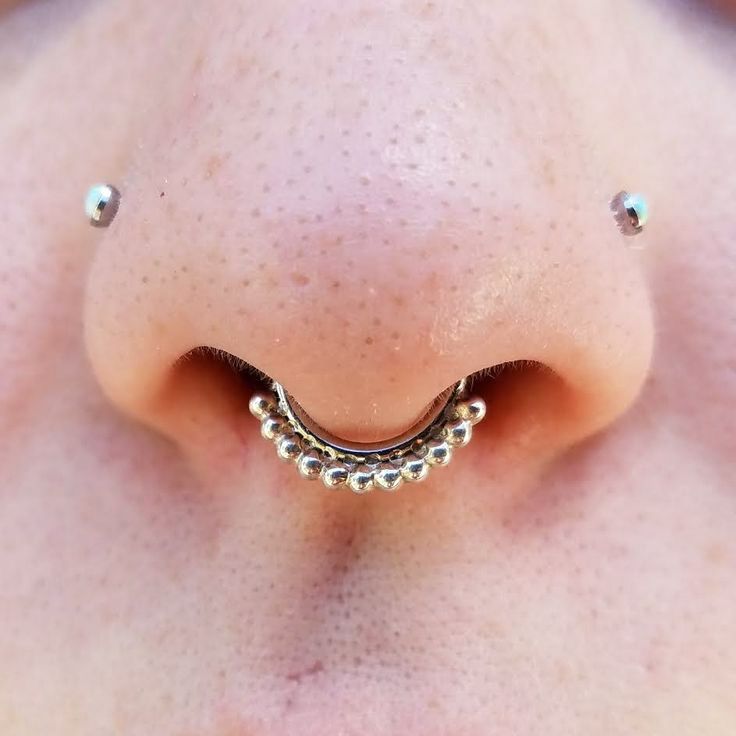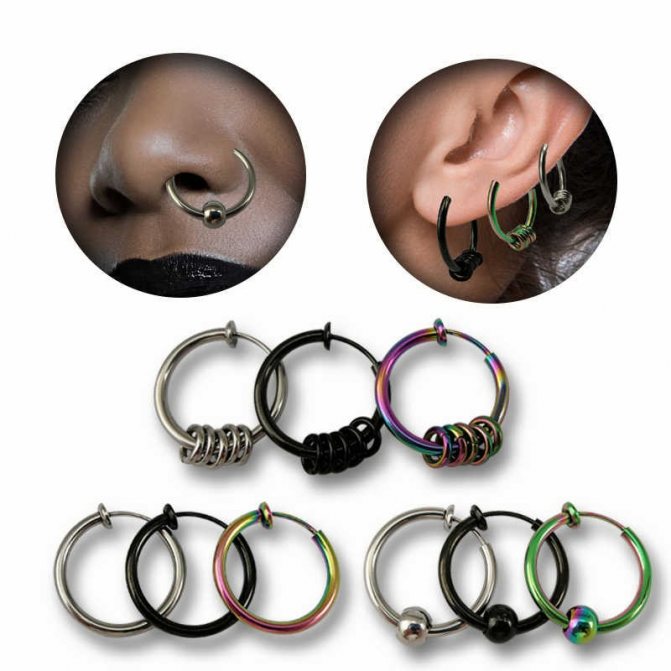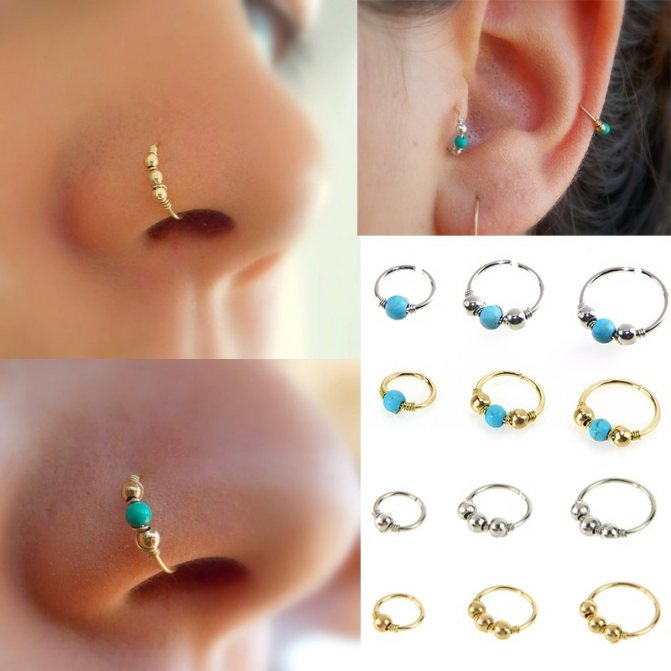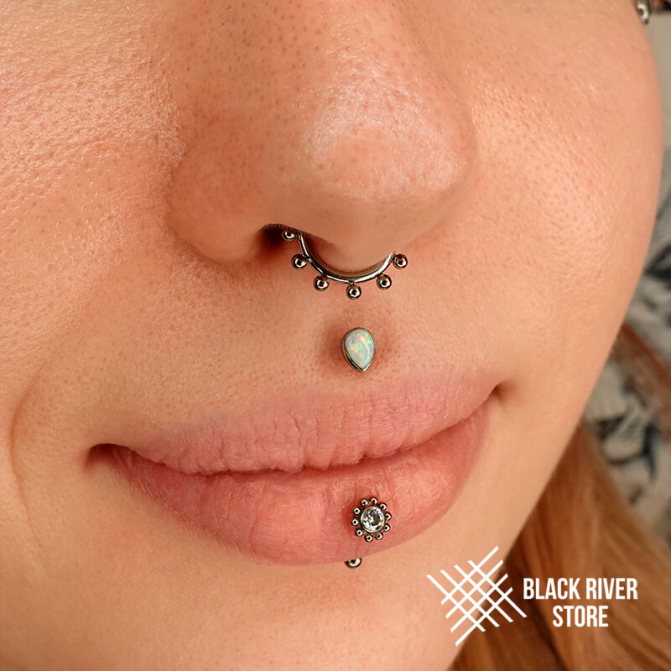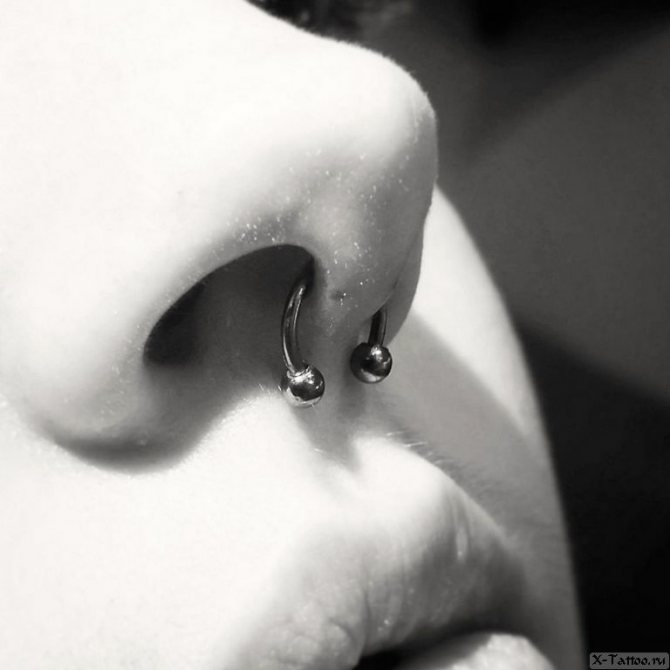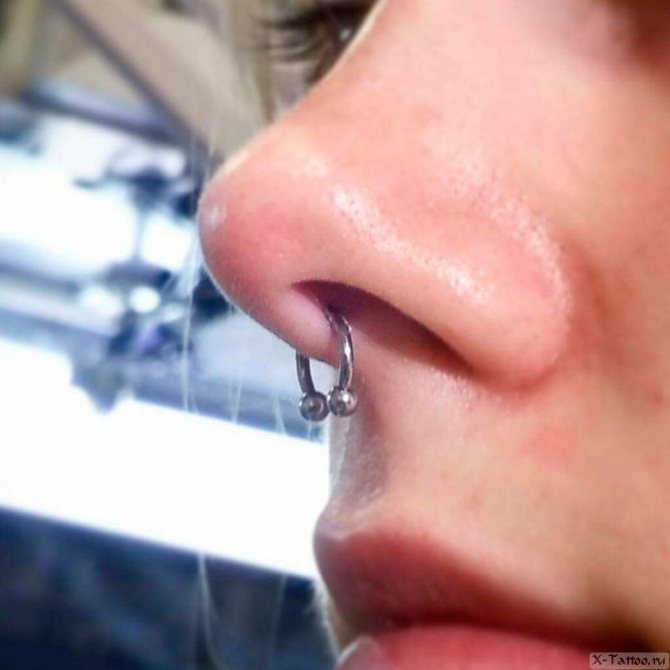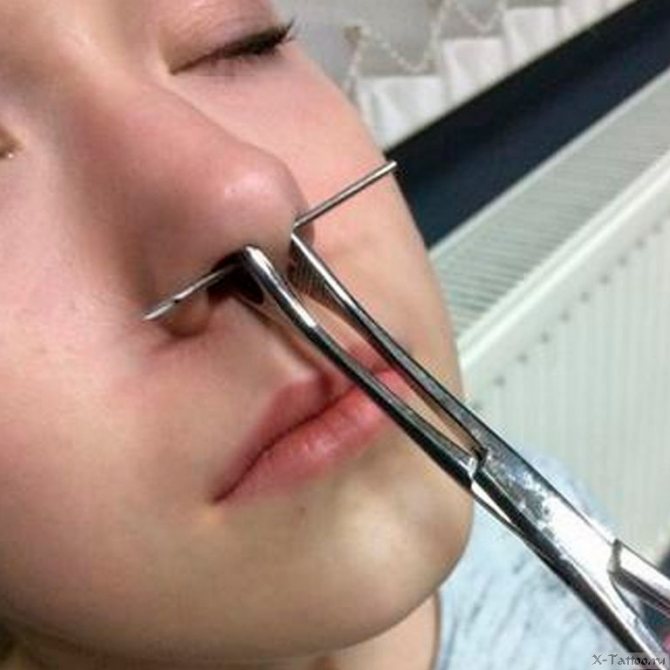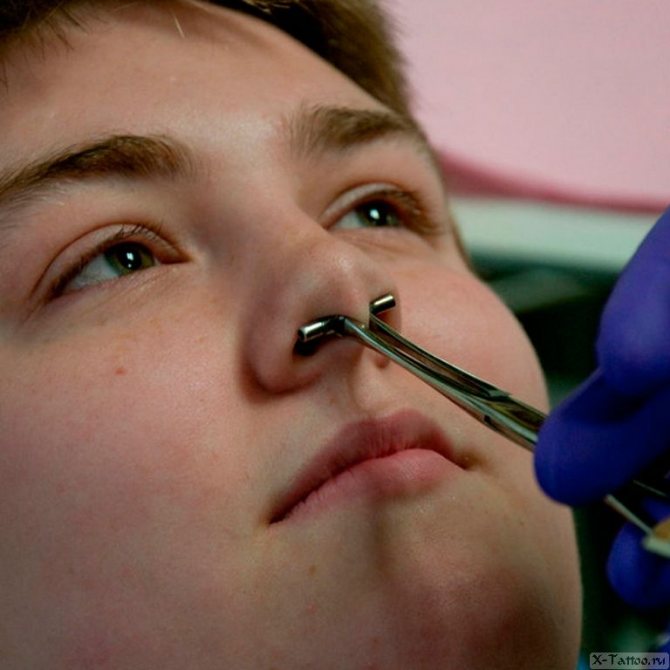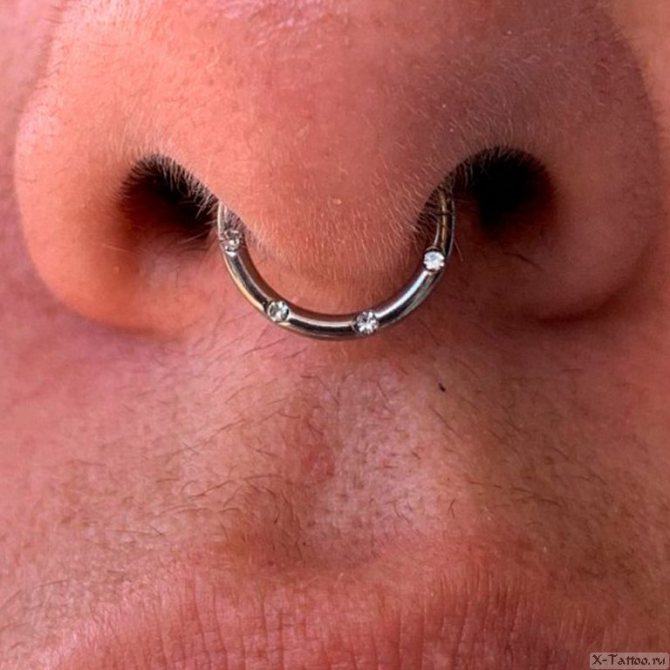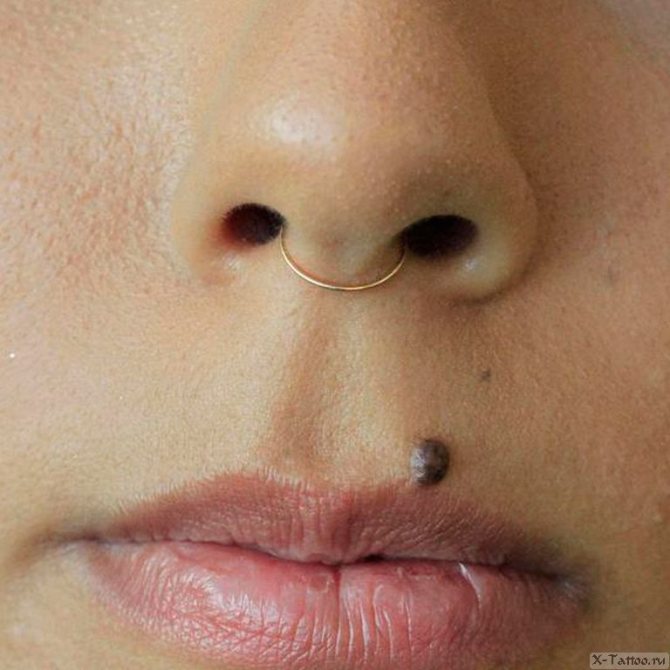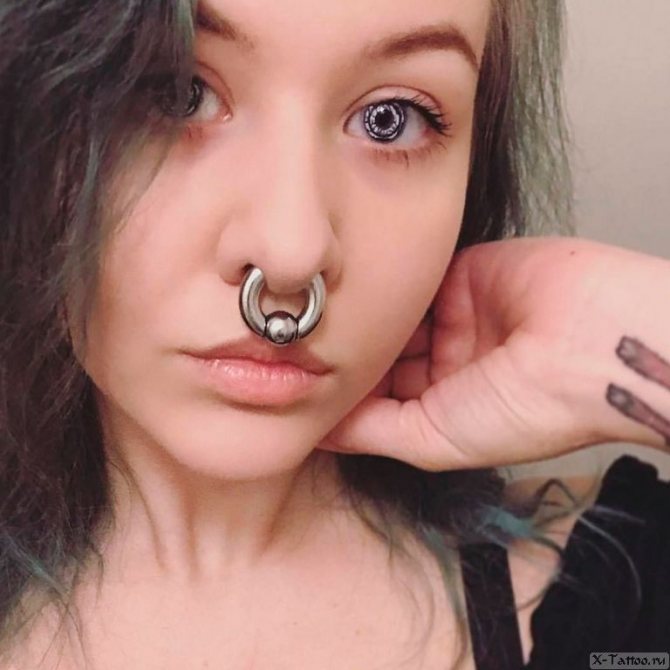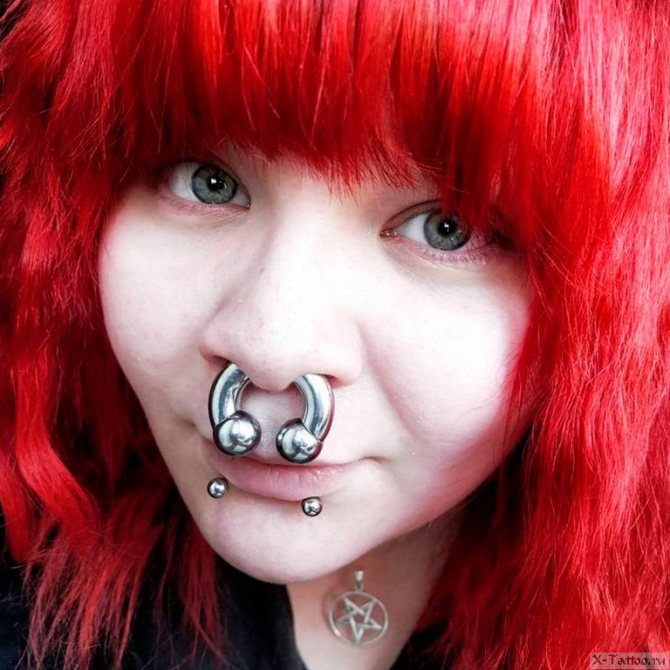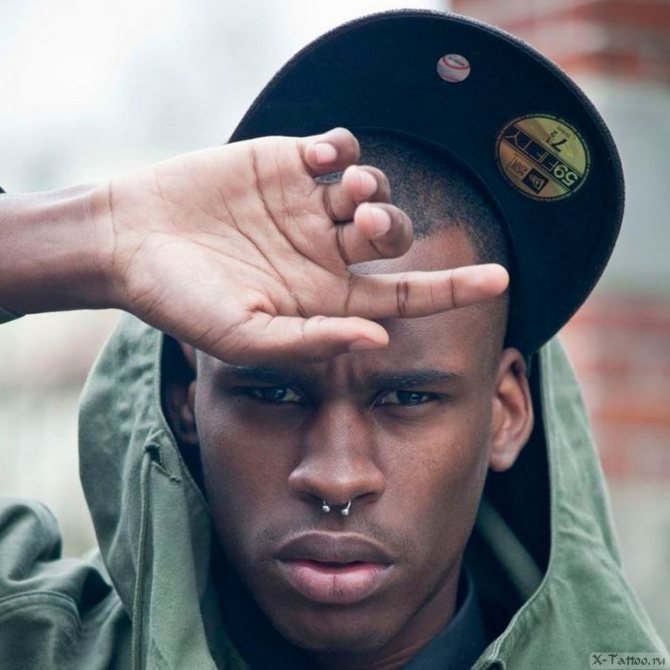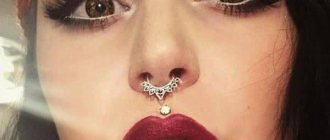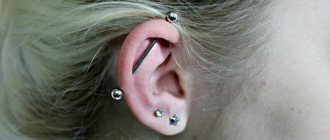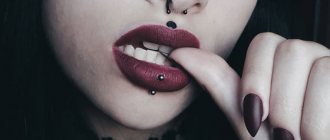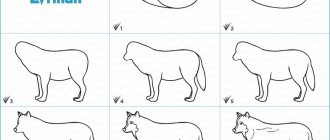The healing process of a piercing
To begin with, you need to understand that piercing is essentially a wound and consider the healing process of a piercing as wound care. Healing can be divided into 3 stages:
- Stage 1 - or the inflammatory phase - a fresh open wound. Bleeding, bruising and swelling are normal during this period, the first few days after the puncture. During this period the blood and intercellular fluid thickens and then granulates. Cells of the basal (base) layer of the skin begin to form.
- The second stage is the growth phase. The period of active wound healing usually lasts about 2 weeks, but in the case of piercings it can last a little longer. At this time, new cells, called epithelial cells, begin to grow on the basal layer from the edges of the wound to the center. The cells fuse together until they finally cover the wound completely. At this stage, the new skin is still very delicate and can tear easily.
- The third stage is maturation or repair. It takes several months to several years before the cells lining the puncture canal from the inside - essentially scar tissue. This is the final phase.
Important Since delaying any of the three sessions can lead to complications, it is necessary to take the most careful care of the piercing and also to use only titanium jewelry, because titanium does not oxidize and is hypo-allergenic, unlike medical steel. With titanium jewelry the healing process will pass without complications.
Normal excretion from the puncture
During the whole healing process, crusts form on and around the jewelry because of the fluid that oozes from the wound. This is a normal part of the healing process. Do not pick these crusts, especially with dirty hands. This secretion should be distinguished from pus, a pale yellow thick fluid with a characteristic unpleasant odor. Pus is composed of white blood cells, bacteria, and dead cells. It appears as a reaction to inflammation or infection. A small amount of pus may be secreted in the very first stage because of inflammation. If pus appears in the later stages, however, it is no longer normal. It is often a signal that there is an infection inside the puncture.
Skin fat is the secretion of your skin glands that accumulates in the healed canals. It is the body's natural secretions, containing fat, keratin and cellular material. Leather grease protects your skin and hair from drying out and prevents the development of microorganisms. It should not be confused with pus, leather grease is more dense and easy to distinguish, despite the fact that it has a slightly putrid smell, as it contains the remains of dead cells.
What to Expect
Minor bleeding, increased sensitivity, swelling or pain are common immediately after the puncture. Occasional minor bleeding can be a nuisance for several days. Even bruising at the piercing sites is normal, although atypical for some types of piercings. If, on the other hand, you bleed frequently and a lot, you should be concerned about it and contact your piercer.
If the piercing bleeds and swells immediately after the procedure, put ice on it. It is better if it is wrapped in a clean napkin or paper towel. Sometimes the puncture site swells so much that you have to replace the jewelry with a looser one. An experienced handyman will do this with a taper so as not to cause you injury.
Punctures that have begun to bleed under the surface of the skin can leave a bright bruise. It can be brightened with a wonderful plant called Arnica Mountain, which is easy to find at the drugstore, in the form of a cream or gel. Simply apply it to the bruise, avoiding contact with the wound.
There are times when swelling can press on a nerve and cause temporary numbness, tingling, and other painful sensations. These are often temporary problems.
It is quite possible if swelling and fluid seepage persist for a long time. It also happens that you may not have bleeding immediately after the procedure, but it may appear weeks or months later. This is normal, and in the absence of other obvious complications, there is no need to worry. Just start treating the piercing as if it were fresh, increasing or decreasing the care regimen as needed.
"healed" does not mean "healed.
If there is no pain, crusts, or bruising, your piercing has passed the first two stages of healing. The puncture hole is smooth, with smooth edges, and not red. If there is skin grease in the piercing - this is a good sign, because it means that there is no longer an open wound inside, and your piercing has come to the last stage of healing - the stage of maturation.
Minimum healing time
Everyone is different, everyone has a different immune system. So do the living conditions and attitudes towards the care of the piercing. Therefore, we can give a very approximate healing time, which can vary significantly in real life. We have indicated above how long it takes for each stage of healing. In order to maximize the healing time, I strongly recommend that you read the article piercing care, it details how to properly care for the piercing.
Check out our new online tattoo fonts service!
How long does a belly button piercing heal?
If properly cared for, the belly button piercing will heal 4-6 months after the procedure. Care recommendations include antibacterial treatment, as well as choosing clothing that is breathable and does not damage the wound. It is also necessary to limit stress, do not jump, do not run, during sleep lie on the side or back, but not on the stomach.
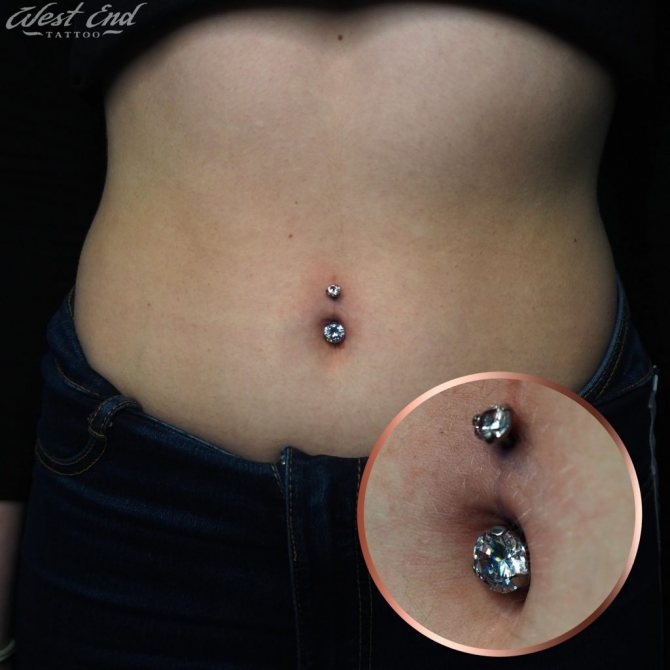
PIERCING PECULIARITIES
Septum is a piercing performed on an area of skin of small thickness. The piercing is done at the top of the nose between the two cartilages, which minimizes tissue trauma and does not cause pronounced pain.
If desired, there can be several holes in the nasal septum. In this case, maximum matching ornaments or, on the contrary, contrasting ones are used. The piercing of several piercings is an unconventional, but quite original solution.
When performing primary piercings, earrings with a thickness of 1.2-3 mm are used. The most popular options are rings, septum clickers, circulars, retainers. Using for this procedure, the earrings with a thickness less than 1.2 mm is impractical - a decorative element can easily break out accidentally, which is fraught with injury. It is also difficult to insert another piece of jewelry into the healed hole of a small thickness. The preferred materials for primary piercing are titanium, gold (nickel-free alloys).
To perform "septum" piercing, it is undesirable to use bananas. In these ornaments there is no pronounced center of gravity. Therefore, they can slip to one side, which looks not very aesthetically pleasing. In addition to bananas, it is undesirable to use a barbell to make the primary piercing, since it is impossible to know whether the hole is evenly placed. By inserting a ring or clicker, however, you can immediately see the error and correct it.
Are there any pain sensations?
Here we must take into account how pain is perceived. For some patients it may be excessive, while others will tolerate it with complete peace of mind. It is impossible to call the procedure absolutely painless. For some people, minor injuries cause squealing and screaming. Others will find themselves enduring even significant injuries.
It is known that men are able to withstand serious pain and not make a sound, while women perceive what is happening more emotionally. Much depends on the skill of the master. Over a relaxed conversation, he will quickly determine the place for the puncture and with the least pain to perform the manipulation.
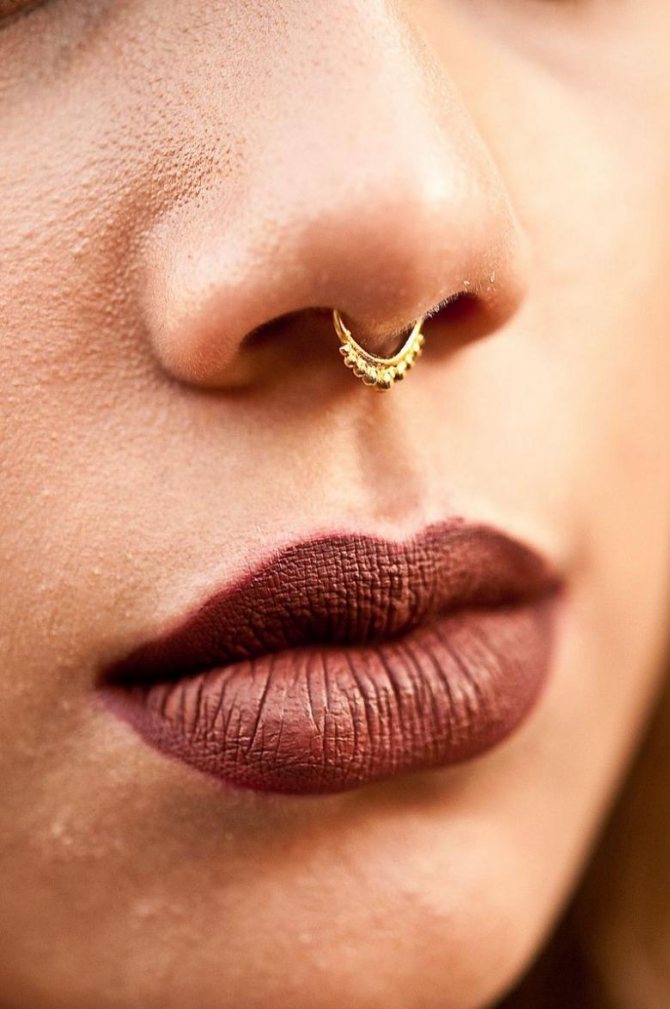

WHAT IS THE APPEAL OF THE SEPTUM?
Septum piercing is a great way of body modification, which is suitable for men and women. Since the puncture is made just above the cartilage, the decoration will not hang over the lip. When the procedure is done correctly, the decorative element protrudes from the nostrils by 2/3. This is quite enough to create a spectacular image and comfortable to wear.
The septum also performs a number of aesthetic functions. With its help it is possible to achieve a spectacular appearance:
- highlight, emphasize or correct the shape of the nose;
- Hide skin imperfections, including scars;
- Make the image as a whole more attractive and original.
Nasal septum piercing is notable also by the fact that it can be hidden from others, without removing the ornament. To do this, in the hole should be a circular or retainer, which, if desired, can be tucked inside the nose. But note that such manipulation is allowed only with fully healed punctures.
If the septum becomes boring or uncomfortable to wear, it can be discarded at any time. No visible scars remain on the body after healing, as is the case with other types of piercings.
Service after piercing
All clients who have had their piercings done by me receive free follow-up consultations and examinations. Also, if you yourself can not change the decoration - come (pre-register for the inspection), and my work on the replacement will also be free.
If something bothers you after the piercing - do not google all sorts of passions-mordache on the Internet, and, especially, to use the "advice" of people without a medical education. You have to ask the doctor who did the piercing.
I don't work with complications from other masters.. All questions and complaints addressed to the person to whom you paid money. I do not fix any "faults" of other masters. Do not have to text me "What to do with it?" Facebook or WhatsApp.
HOW DO SEPTUMS GET DONE?
The septum piercing is performed with the following sequence of actions:
- The master together with the client chooses a piece of jewelry, stipulates the details and possible negative consequences.
- The specialist prepares a needle for individual use, disposable gloves. In the meantime, the jewelry and the working tool are treated in a sterilizer.
- The necessary area of the skin is seized with special tongs, marking and disinfection is performed.
- Quick confident movement of the master pierces the skin, not touching the cartilage tissue.
- An earring is gently inserted into the hole.
- The wound is treated with antiseptics.
A full healing takes 6 to 8 weeks. If desired, the primary jewelry can be changed in a month after the procedure.
Possible consequences
Any experienced master before the procedure will explain in detail how to care for and warn about complications. The most common one is infection. To be on the safe side, use sterile gloves and treat the wound with a formulation of Chlorhexidine or Myrmistine.
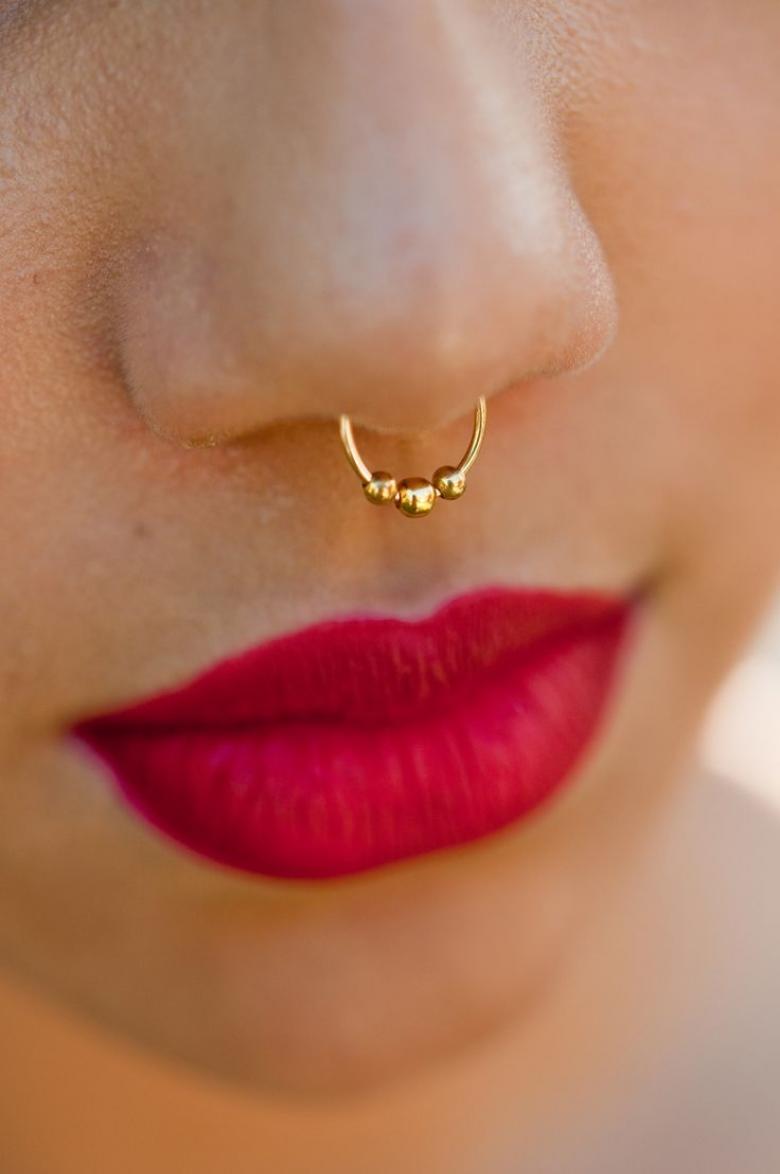

If keloid scars appear, causing redness, burning and itching, medical attention should be sought as soon as possible. Septum in today's conditions with modern disinfectants is a relatively safe manipulation that many guys and girls resort to!
SEPTUM CARE
In order for the septum piercing to heal faster, it is necessary to follow simple rules. It is necessary not to interfere with the body's own recovery and carefully monitor hygiene. In the wound surface should not get dust, dirt, it is forbidden to touch the piercing with unwashed hands.
For the care of piercings, two medicines are traditionally used - saline and miramistine. A small amount of sodium chloride solution is poured into a clean container and the nose is gently lowered into it. At this time, you should breathe through your mouth. Such a bath should be used for 3 minutes.
After the procedure, using a cotton swab from the wound remove the soaked secretions. As a result, it will be possible to get rid of dried crusts on the mucosa, without traumatizing it. At the end, the wound is treated on both sides with a treatment with MIRAMISTIN. The same procedure is repeated twice a day for 2-3 weeks, or until healing.
The care of the nose piercing is also to prevent negative effects on the piercing. It is forbidden to rub the jewelry, the first time to remove it independently, to treat it with alcohol-containing products. Within a month after the procedure, refrain from visiting the solarium, sauna, swimming in the pool and open ponds.
What is better for cartilage piercing - a needle or System-75
It's up to you to choose. I think that for cartilage piercing (nose or auricle) "System-75" is ideal, because: - it does not crush the cartilage like a classic gun (you cannot pierce cartilage with a classic gun!), - the earring-needle is much thinner! than the classic needle catheter used for piercing, - the piercing is many times faster than a classic needle, which minimizes discomfort for the patient, plus, the piercing tool itself is already a decoration. Otherwise, the piercing mechanism is equivalent.
But if you are a fan of classic old-school BDSM - of course, I can pierce with a classic catheter needle, too )) You want more pain, you're welcome. You have to suffer, not me ))
- Topical topic: The instructions for caring for your earlobe after the piercing
PIERCING CARE
Piercing is a very popular service of body decoration for many years. Many women and men in this way to emphasize their style, their personality. This service is especially popular among the younger generation. Young people prefer original and unusual body piercings: eyebrows, cheeks, tongue, nose, tunnels and so on. But to make the piercing always look great and effective, it is very important in the first weeks after the piercing, to pay special attention to the care of the pierced area of the body. The care of the piercing is a very important procedure, which affects not only the quality of the service, but also your health. If you follow all the necessary recommendations of the master, the piercing will heal rather quickly, without various inflammatory processes and complications.
In the first period after the procedure, the piercing will need to be frequently washed with antiseptic agents. During the first fourteen days, washing should be done up to five times a day. After that, up to two months, you can wash the puncture only once a day. It is also worth noting that the number of rinses depends on the type of piercing. For example, a pierced ear is much easier to treat than a flat piercing, which requires a longer treatment time.
The most popular antiseptics for piercing care are "Miramistin" and "Octenisept". These are ready-made solutions that no longer need to be diluted, they must be applied in pure form. For this purpose, a cotton tampon or disk is abundantly moistened in the antiseptic, and then attached to the puncture site in order to soak the crust that has formed. After the crust has soaked, you need to gently twist the earring and also treat it with antiseptic. It is important that the solution gets into the puncture channel itself, so that the wound will heal faster. It is also important to note that you should not use iodine, alcohol or hydrogen peroxide to treat a puncture.
Who is suitable?
It is impossible to determine who is better suited for septum, and for whom it is unacceptable. People resort to it as a special kind of art, which can change the face. Because of the piercing of the septum the nose is visually lengthened, so those who have a sharp nose need to be especially careful when choosing jewelry. Women and men resort to this type of piercing.
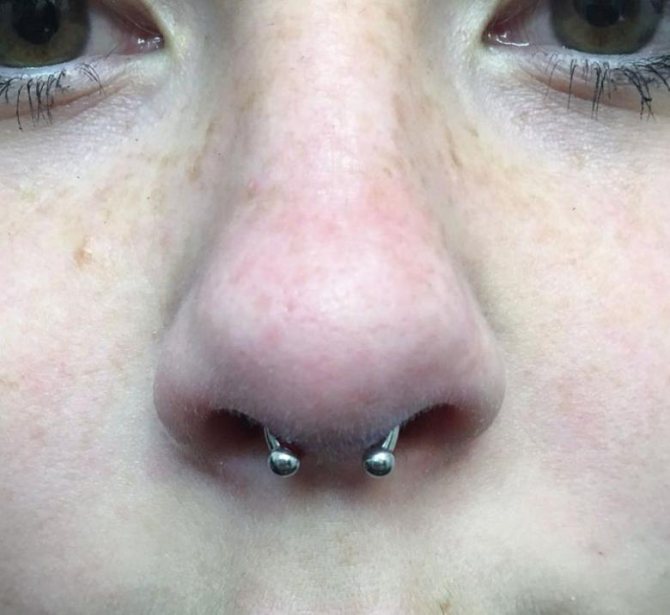

RESTRICTIONS DURING THE HEALING PROCESS
1. It is undesirable to smoke in the first two to three hours after the piercing procedure.
2. Refrain from drinking alcohol the day before and the day of the piercing, as well as on the following day.
3 Refrain from visiting swimming pools, saunas and bathhouses until your skin has completely recovered from the piercing.
Restrict yourself from bathing and taking hot showers. Showers can only be taken at room temperature.
5. Avoid getting cosmetics (lipstick, foundation, powder, etc.) on the piercing area.
6. Do not unnecessarily touch the earring, pull it or tug on the jewelry.
7. Do not touch the piercing site with dirty hands.
8. Do not go to public swimming places.
9. The earring must match the type of piercing, as well as be comfortable.
10. 10. It is extremely important that the earrings always be completely sterile, with no crusting and no boils.
It is necessary to take care of the piercing on a daily basis. Remember, the quality of healing of the pierced body area depends on your treatment. It is important in the healing process to prevent inflammation, which can later turn into serious consequences. If the puncture site starts to become inflamed, do not self-treat. In the first place it is necessary to contact the piercer, and if necessary - a doctor.
Also, with the healing of the piercing, it is necessary to include taking vitamins or vitamin supplements. By saturating the body with nutrients, you also take care about the rapid healing of skin cells.
How long does a nose piercing heal?
If you follow the rules of care, the healing of a nose piercing takes from 4 to 10 weeks. However, it takes six months to remove the jewelry without harm or risk of infection.
Reddening, secretion of crusts remain for about two weeks. Regular treatment with "Chlorhexedine", "Miramistine" and other means prescribed by the master will help accelerate the process. In order to get disinfectants not only on the surface, but also inside the puncture hole, it is necessary to twist the earring slightly.
HOW LONG DO DIFFERENT BODY PIERCINGS HEAL?
- Lobe piercing heals from four to six weeks.
- Ear cartilage piercings take three to six months to heal.
- The tongue takes up to six weeks to heal.
- The septum takes eight weeks to heal.
- Lip piercings take about four to eight weeks to heal.
- Monroe piercing takes up to ten weeks to heal.
- The labret takes eight to ten weeks to heal.
- The bridge heals for up to ten weeks.
- Eyebrow piercings take eight to ten weeks to heal.
- Wing piercings take six to eight weeks to heal.
- Belly button piercings take from three to six months to heal.
- Flat piercings take up to nine months to heal.
- Microdermal piercings take six to nine months to heal.
- Nipple piercings take up to ten weeks to heal.
- Clitoral piercings take four to eight weeks to heal.
- External labia piercings take three to five months to heal.
- Internal labia piercings take six to ten weeks to heal.
- Christina piercings take up to five months to heal.
Any type of piercing in the first few days after the piercing can swell or turn red. Also, there may be a little bit of redness. This is normal. Thus, the skin regenerates new cells for the closure of the wound. But if you see any of the following changes, you should see a specialist as soon as possible:
- The redness does not go away for a long time;
There is a hardening or swelling around the punctured area;
Painful lasting sensations at the site of the puncture, fever;
- purulent discharge (yellow, green discharge).
There are cases when the infection is confused with irritation from chemicals. Therefore, during the healing of the pierced place, limit the use of chemicals, as well as cleaning products and other irritants.
PIERCING REJECTION
It is not an uncommon case when the body rejects the earring. Most often, rejection is accompanied by unpleasant painful sensations, but not always. If the pain is not felt, the rejection of the jewelry can be distinguished by the factors listed below in the text.
1. The puncture gradually expands, a transparent liquid is released.
2. Constant itching is felt at the puncture site, and a rash may form.
3. The earring is translucent through the skin.
The most common reason for the body not accepting the jewelry is that the alloy of the earring did not fit you. Most likely you will have to replace the jewelry with an earring of another material. But it is worth noting that it is necessary to consult a specialist in advance, who will help you find out what the reason for rejection is. Also, the master will give a number of subsequent recommendations on the care of the pierced part of the body.
HOW TO ACCELERATE THE HEALING OF PIERCINGS?
The healing period of some piercings lasts quite a long time. The piercing may take several months to heal. So what can be done to speed up healing? In this case, the treatment of the piercing site is suitable sea salt raster. How to treat a piercing with sea salt:
It is necessary to wash your hands thoroughly; antibacterial soap, without aroma - additives, creams and other impurities is suitable for this purpose;
Use a cotton pad and water to remove the residue of blood vessels and other secretions from the earring;
Sea salt helps to accelerate the healing of the puncture, dispose of irritation and inflammation. In addition to this treatment, you need to strictly observe the norms of hygiene, as well as proper nutrition. Add more fruits to your daily diet, you can take vitamin supplements.
Important! Diabetes mellitus requires control of blood sugar, so that the healing process does not turn into a long period. In this case it is necessary to supplement the body with zinc, so that the puncture would heal faster. Also, it is worth noting that diabetes should not take a lot of vitamin C, because it makes the blood thicker, which inhibits the healing of the piercing.
PRECAUTIONS FOR PIERCINGS
In order for the piercing to heal faster, the following precautions should also be included in the care of the piercing:
- When piercing below the neck, refrain from tight, rough clothing, refrain from collars;
Also, physical activity should be kept to a minimum;
When piercing the ears do not allow close contact with hair, headphones, phones, so as not to disturb the healing area once again;
face piercings do not allow cosmetics to get into the area of the piercing;
Important! If you, for any reason, for any method of care for piercing, do not do self-treatment. First of all, contact a specialist, and he will find a new method for the treatment of the piercing together with you.
How long does a tongue piercing heal?
Tongue piercings take 3-4 months to fully heal. This is quite a long period, during which it is important to rinse your mouth regularly with disinfectants.
Whether the tongue piercing will heal without complications - depends not only on regular treatment of the wound, but also on the implementation of recommendations on food intake. In the first few days you should stick to a liquid diet - eat only mashed potatoes and broths. Soft warm food is allowed when the initial inflammation passes, the severe pain is gone. During the recovery period, it is important to give up alcohol, as well as hot, cold, sour, spicy food.
What is a septum piercing and its piercing features
A piercing called a septum is a piercing performed in the central nasal septum, located between the nostrils. In most cases, the septum is pierced in the upper part, at the junction of the two cartilages. This minimizes their traumatic effect. The jewelry is visible from the nostrils, it is located above the upper lip. There are various accessories - rings, curved half-rings, rods.
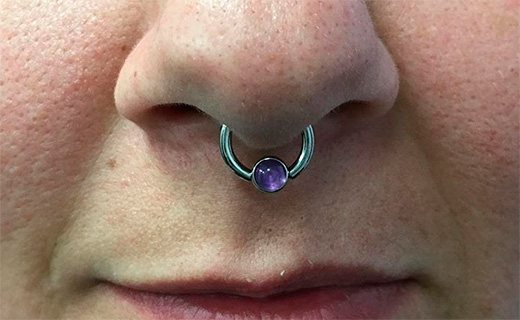

Basic rules for wearing jewelry for piercings
It is important to understand that jewelry for a new piercing must be completely sterile. Nothing can guarantee the sterility of the jewelry like sterilization in an autoclave. An autoclave is a special piece of equipment that professional piercers use to clean jewelry and tools.
Buy jewelry only from trusted placesOnly buy jewellery from trusted places, salons and studios that will be able to present you with a jewelry certificate. After you have bought the jewelry you should disinfect it before you put it on.
Do not take jewelry that has already been worn by someone else.. This applies to wear in fresh piercings as well as healed ones. If the studio provides an exchange of jewelry, in any case do not buy jewelry there, there is no guarantee that the purchased jewelry has not been worn before you.
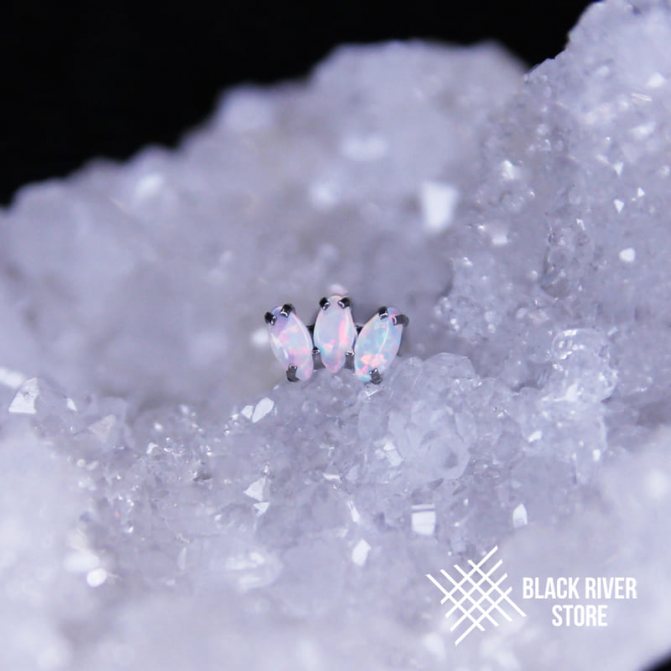

What is and peculiarities of septum piercings
Septum piercing is performed on a minimal area of skin, which significantly affects the procedure itself on the formation of the hole and the rehabilitation period.
The piercing has deep historical roots. It was first used a thousand and a half years before our era. The inhabitants of India used it in performing rituals. The piercing of the nasal septum was invested with great sacred meaning. In those days, girls made the hole, believing in its help in childbirth and easy upbringing of the child.
Often the ring was supplemented with a variety of pendants, having a large weight. After time, septum piercings took root in other countries and peoples. There were Aboriginal people in Australia who used heavy jewelry to make their noses look flat, which they thought was attractive. Asian women still pierce their noses before getting married in order to look more beautiful and desirable to their beloved.
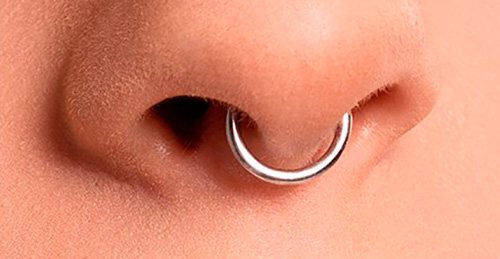

Today, a young guy or a man in his 30s or 35s decides to get this type of nose hole more often. Basically, it is representatives of the rock culture. Women prefer to make a piercing on the wing. The pierced nostril looks neat and sexy, unlike a barbell or ring on the edge of the nose.
The concept
Piercing involves piercing the septum of the nose where the cartilage connects. This custom has existed since ancient times, when people in wild tribes, in an effort to appear significant and important, pierced that part of the nose where the cartilage was, and then inserted a massive object. Most often they were small bones of killed animals. This was how they put fear into their enemies.
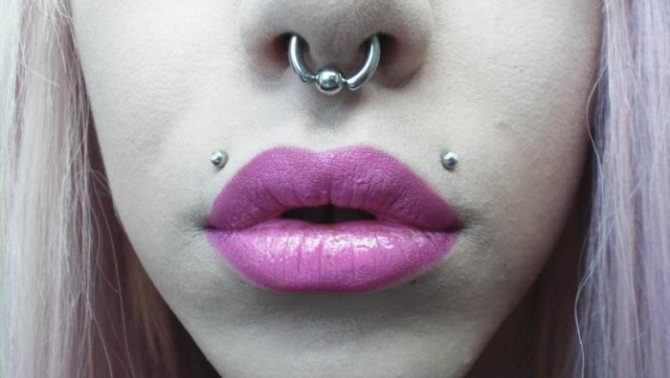

Until the present day, the septum has not lost its basic meaning in some Asian peoples who continue to follow the traditions established by their ancestors. The girls who followed this rule increased their attractiveness and were considered to be more desirable brides.
In India, women performed the procedure when they were about to give birth, hoping for a quick and easy baby.
Subsequently, the tradition of nasal piercing was adopted by the inhabitants of European countries. Very soon it became part of the culture. In 70-80-ies piercing were only punks, protesting against the existing order. Today, nose rings look original and are a kind of fashion mainstream. Now jewelry picks up a variety of shapes that look more elegant.
How does the piercing go
In order for the operation of piercing the soft tissues of the nose to be successful, it is necessary to entrust it only to a master with appropriate qualifications and extensive practical experience. Contact a salon with a good reputation, where the rules of asepsis are observed and the hole is properly formed.
We recommend reading:
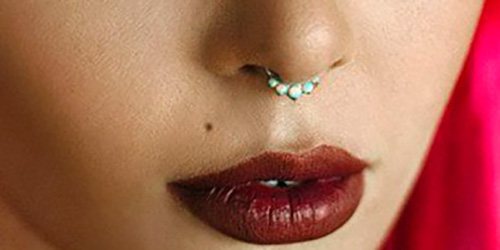

How to make a nose piercing in the septum area:
- The master and the client discuss the diameter of the future canal and select an ornament.
- Reusable tools and the earring are placed in a special device for disinfection.
- While the instruments are being prepared, the specialist advises what are the consequences, contraindications and how to care for a fresh wound.
- The specialist puts on sterile gloves and removes a disposable needle from its individual package.
- With pliers, an area of skin is grasped and pulled away, marking and disinfection is done.
- With a quick movement, the needle is inserted and the nasal puncture is made. The operation is carried out only in the soft tissues, the septum is not affected.
- Without removing the needle, the tip is cut off and an earring is inserted into the hollow part, pulled through the hole. The earring is fixed.
- Fresh piercings are treated with antiseptic.
If the procedure is performed correctly, the patient experiences pain for 1-2 minutes and further healing depends only on compliance with the rules. There is no anesthesia.
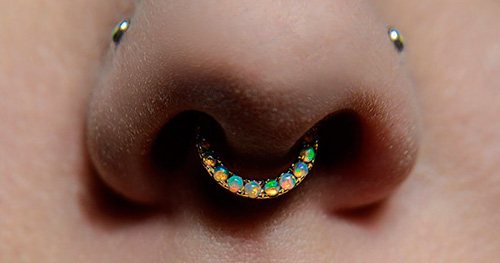

What is it?
The word "septum" (lat. septum) translates as "septum". A septum piercing is a piercing of the nasal septum in and between the nostril. If you pinch it with two fingers, you will feel two cartilages there. One goes along the entire nose from top to bottom and the other goes from your upper lip to the tip of your nose. In the place between these two cartilages (which is where the thinnest part of the septum is), just a puncture is made. Closer to the tip of the nose.
In the time of our ancient ancestors, such jewelry played an important role in the culture of the tribe. By piercing the septum, tribesmen inserted various objects into the nose. Some peoples did this to intimidate enemies by inserting animal bones. Others are to indicate rank and importance in the tribe.


It is interesting that some such tribes still exist in our time. To this day they have septum piercings as part of their culture.
Modern people use the piercing as a beautiful earring. Guys and girls around the world pierce the septum to stand out and be original. Most often it is creative individuals who do not want to live like the gray majority.
Can it be done at home
We strongly recommend to perform minimally invasive procedures in the conditions of a salon, where the service is provided by a professional master. Home conditions contribute to the development of complications. But if you decide to inject yourself, remember that the operation must take place according to the rules.
- Be sure to disinfect the earring. To do this, boil it, put it in hydrogen peroxide for 20 minutes.
- Stab only with a special needle! You can buy it in a drugstore. Keep it sterile until you start working, do not take it out of its individual package.
- Treat the septum puncture site with antiseptic.
- Make the markings according to the photo instructions. If you capture a small fold of skin, there will be a melting of tissues and rejection of the jewelry. Grabbing a large area threatens to damage the cartilage.
- Use the special tongs to smoothly move the needle. They are sold in specialty stores and medical supplies.
- Make a grip, pull back the skin and with a quick confident movement make a puncture.
- Without removing the needle, insert a part of the earring design into its hollow part or into the catheter, put it through the hole until the rod or ring fully enters the canal, close the clasp.
- When the operation is over, treat the wound with antiseptic.
Before the procedure, you should have no signs of an acute respiratory infection and your body temperature should be normal. Piercing is contraindicated in case of rhinitis or pollinosis, otherwise inflammation will develop and complications pus, pain, infection will occur.
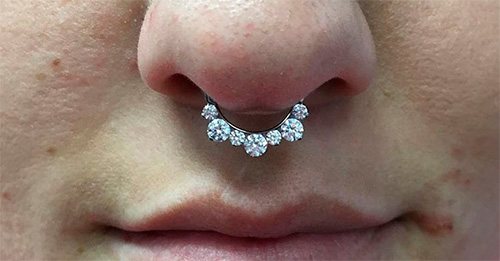

The most dangerous and terrifying consequence of septum is the removal of the nasal septum.
How long does a lip piercing heal?
In this area, recovery takes 1.5-2 months. Already after 2 weeks, the swelling subsides, redness disappears, crusts appear and discharge stops. To accelerate the healing of the lip piercing will help treat the wound with antiseptics. The main thing is not to remove the jewelry, even for the period of care procedures.
During the recovery period you should avoid alcohol, spicy food and smoking.
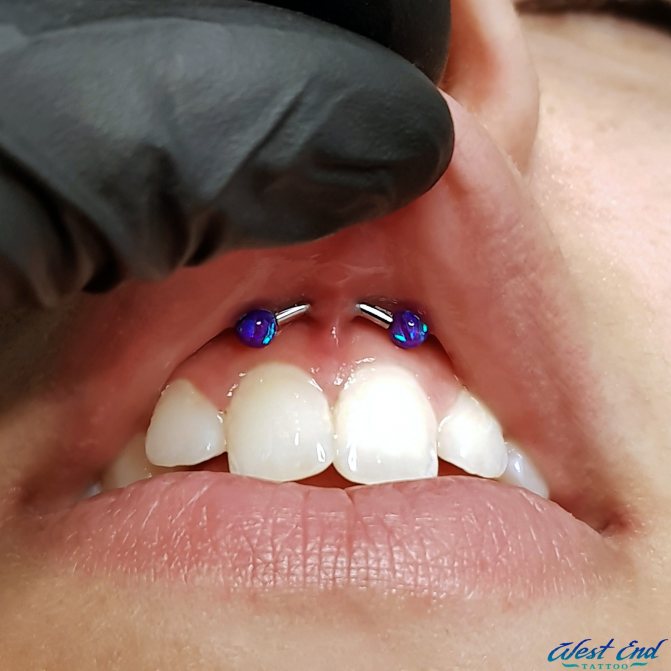

Choice of jewelry
The following varieties of earrings are suitable for septum:
- rings of the classic look;
- Bananas and barrettes;
- Half rings (horseshoes).
To avoid the development of an allergic reaction, all jewelry inserted into a fresh wound should be made of the following hypoallergenic materials:
- bioplastic;
- gold of the highest 750 proof;
- titanium.
Titanium is considered the gold standard for safety and quality. This material does not oxidize, does not contain dangerous inclusions, and promotes quick healing.
The diameter of the primary jewelry is 1-2 mm. The length for men is recommended in the range of 10-12.5 mm, for the fair sex - 8-10 mm.
The garter can be changed after 2-4 weeks, provided that the healing is good. If the canal is formed and does not hurt, then after a month you can replace it with another type of product.
How to hide the septum before an important event, where a strict dress code is assumed? Use miniature jewelry with small retainers around the edges. The best option is bananas or barrettes.
After healing, it is possible to replace them with earrings of sterling silver, gold 585, wood, platinum, bone.
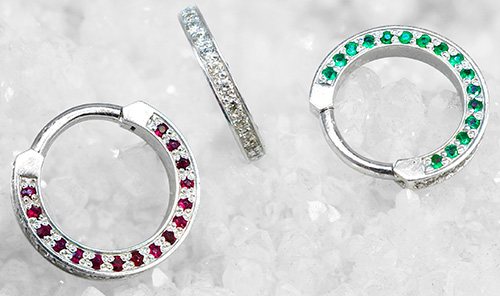

What is the best metal for jewelry
TitaniumIt is the most hypoallergenic, and at the same time strong and lightweight metal. Currently, it is titanium (not medical steel) that is used for permanent pins and implants inside the human body.
Medical SteelHigh purity steel. A tough, wear-resistant metal that is not susceptible to corrosion.
Metal Anodizing.Both titanium and medical steel can be anodized - that is, given a different color (such as gold, or black, or any other, or iridescent) without changing the properties of the base metal. Anodizing is often used in jewelry.
GoldSeems to me to be a rather controversial metal for jewelry. To be more exact, it is not the gold itself, but its hallmark: the classic Russian 585, which contains nickel as a solder, for example. Very often mothers who have pierced children's ears complain that "when we start putting gold earrings in, their ears begin to hurt and fester. This is a sign of metal intolerance. More precisely, most likely, the solder. The American brand "Stadex", which I work in the office, has a special series of hypoallergenic jewelry "Sensitive" - it is jewelry made of medical steel, covered with pure gold of 999th hallmark. I really love this series, and recommend it to everyone. The jewelry looks gorgeous on both adults and children and does not cause allergies.
Wound care and possible consequences
How long does the healing period of the septum last? If all goes without complications and inflammation, the wound will heal in 6-8 weeks. Regular care is necessary for successful rehabilitation.
- The puncture must not be touched with the hands, the earring must not be threaded.
- The wound is treated with a cotton swab soaked in antiseptic or salt solution.
- In order to heal the inner nasal mucosa, it is recommended to carry out the injection of drops containing sea salt.
- Do not peel off the crusts so as not to get an infection.
- Do not use foundation concealer and other cosmetics.
The septum looks beautiful and provocative, but it requires a minimally invasive surgery, which can lead to complications. If you decide to have a piercing, take into account all the nuances and follow the rules of care. Neglectful attitude to the piercing threatens inflammation, rejection and destruction of the nasal septum. Be attentive and carefully monitor the healing process.
How long does an eyebrow piercing heal?
Full regeneration of the skin in the eyebrow area takes 2 to 3 months. To avoid complications, during the period of healing of the eyebrow piercing it is necessary to treat the wound with antiseptic agents, gently remove secretions with a cotton disc. The earring should be moved very carefully, so as not to damage the recovering skin.
Specialists do not recommend sleeping on the side where the piercing is located. It is also important to change the pillowcase every day while there is still discharge. This will help avoid infection.
How to choose a place for the jewelry
Microdermal implants can be placed on any part of the body - the neck, the neckline, the collarbones, the abdomen and the back. Many people like to decorate the face, hands, others attach titanium constructions where they can remain invisible - behind the ear, around the navel, on the lower back. It is desirable not to touch the zone with the implant with the clothes, not to expose to a regular traumatization.
Piercing on the neck
Effectively looks microdermal on the neck - this is one of the most popular places of installation. Often the stones decorate the following areas:
- The jugular fossa, a depression on the lower part of the neck formed by the legs of the sternoclavicular mastoid muscle. Such adornment resembles a pendant, which appeared in its usual place without a chain.
- The central line of the posterior surface of the neck - then several pieces are set on top of each other.
- The lateral part of the neck, which begins at the top of the trapezius muscle and ends behind the ear.
Microdermals on the clavicles
The next popular area of the body where an anchor earring is placed is the clavicle area. The subclavian or supraclavicular fossa is used. It is not necessary to fix the jewelry symmetrically - products implanted in the pierced clavicle or supraclavicular area from one side look spectacular. Piercing on the collarbone should not be chosen by those who do not wear clothes with a neckline - the protruding parts of the product will regularly hurt the fabric.
Microdermals on the face
Install microdermal on the face of the most daring and advanced. Stylish and effective look round products in the form of a shiny stone on the side of the lip, on the cheekbone, in front of the concha, above the bridge of the nose between the eyebrows. Sometimes on the face they make a puncture in several places at once, where they attach titanium "earrings" - then they resemble a traditional piercing. This procedure has a disadvantage - there is a possibility that after the removal of ornaments formed a scar.
Lower back piercings
Implantation of titanium jewelry in the lumbar region is done both by women and men. If a girl has pronounced dimples on her back at the junction of the pelvis and spine, products shaped like a disc or sphere can be installed in them. Since this feature is more common in women, men do piercings in the lower part of the spine in the form of a track of several shiny elements.
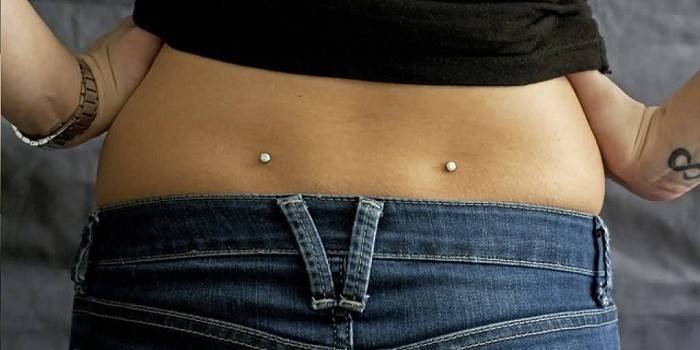

Piercing in the cleavage area
Decollete piercing is a prerogative of the weak half of mankind. A microdermal in the cleavage between the breasts looks sexy and unobtrusive. Installed as a single piece of jewelry, as well as several pieces arranged in a vertical stripe. Harmoniously look products, the size of which decreases from top to bottom. However, it is worth remembering that jewelry can get caught by the bra, so before installing it in the decollete zone it is worth weighing everything.
